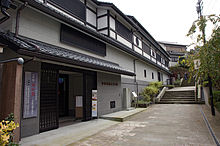Tachibana Akemi

Tachibana Akemi ( Japanese 橘 曙 覧 ; also Tachibana no Akemi ; * 1812 in Ishiba-machi, Echizen Province (today: Tsukumo, Fukui , Fukui Prefecture ); † October 13, 1868 in Fukui) was a Japanese Kokugaku scholar and Waka - Poet.
Names
His original family name was Shōgen ( 正 玄 ). His first name was in his childhood ( yōmyō ) was Gosaburō ( 五 三郎 ) and his real name as an adult was first Shigetoki ( 茂 時 ), later Naokoto ( 尚 事 ). In 1844 he changed his family name to Tachibana and in 1854 his first name to Akemi.
Occasionally it is also carried under the name Ide Akemi ( 井 出 曙 覧 ).
As a Kokugaku author, he used the pseudonyms Koganenoya ( 黄金 舎 ) and Shinobunoya ( 志 濃 夫 廼 舎 ). Another pseudonym was Reiin ( 霊 隠 ).
life and work
Tachibana was born as the son of the paper merchant Shōgen Gorōuemon ( 正 玄 五郎 右衛門 ) and his wife Yamamoto Tsuruko in the castle town of Fukui , Ishiba-machi. His mother died when he was two years old and his father when he was 15. He then went to the Nichiren Buddhist temple Myōdai-ji in Nishidaidō, Minami-Echizen , where he studied Buddhism under a priest. At 18 he went to Kyoto where he attended the private school of Kodama Kizan , but returned to his homeland after a few months. In 1833 he married Naoko. In 1844 he became a student of the Kokugaku scholar Tanaka Ōhide in Takayama .
After he handed over the family business to his half-brother in 1839, the entire family fortune followed in 1846 and he began a life as a hermit - first on Mount Asuwa and from 1848 in Mitsuhashi (today: 2-chōme, Terute, Fukui). Here he attracted the attention of his sovereign ( daimyō ) Matsudaira Shungaku and his adviser Nakane Yukie , who offered him a position in the castle, which he refused, although he was supported financially.
Tachibana was one of the circle of poets who tried to renew the traditional Waka poetry in the 19th century. Politically, he was a supporter of the empire and was in opposition to the Tokugawa shogunate . He died a few months after the restoration of imperial rule . His tomb is in the Daiansen-ji ( 大安 禅寺 ) temple in Tanotani-chō, Fukui.
With Shinobunoya kashū ( 志 濃 夫 廼 舎 家 集 ) a collection of poems appeared as early as 1878. Ide Kinji published a complete edition of his works with Tachibana Akemi zenshū ( 橘 曙 覧 全集 ) in 1903.
Individual evidence
- ↑ a b c d e f 橘 曙 覧 に つ い て . (No longer available online.) Fukui, September 24, 2010, formerly in the original ; Retrieved February 12, 2012 (Japanese). ( Page no longer available , search in web archives ) Info: The link was automatically marked as defective. Please check the link according to the instructions and then remove this notice.
- ↑ a b c d e 飯 倉 洋 一 : 橘 曙 覧 . In: 朝日 日本 歴 史 人物 事 典 at kotobank.jp. Asahi Shimbun Shuppan, accessed February 12, 2012 (Japanese).
- ↑ 井 出 曙 覧 . In: 百科 事 典 マ イ ペ デ ィ ア at kotobank.jp. Hitachi Solutions, accessed February 12, 2012 (Japanese).
- ↑ The character 隠 is just a substitute for another character that is not present in modern Japanese typesetting.
- ↑ Donald Keene : Anthology of Japanese Literature, From the Earliest Era to the Mid-Nineteenth Century . Grove Press, 1955, ISBN 0-8021-5058-6 , pp. 30 ( limited preview in Google Book search).
literature
- Ide Kinji (Ed.): Tachibana Akemi zenshū . Fuzanbō, Tokyo 1903
| personal data | |
|---|---|
| SURNAME | Tachibana, Akemi |
| ALTERNATIVE NAMES | 橘 曙 覧 (Japanese); Tachibana no Akemi; Ide Akemi |
| BRIEF DESCRIPTION | Japanese poet and Kokugaku scholar |
| DATE OF BIRTH | 1812 |
| PLACE OF BIRTH | Ishiba-machi, Echizen Province (today: Tsukumo, Fukui , Fukui Prefecture ) |
| DATE OF DEATH | October 13, 1868 |
| Place of death | Fukui |